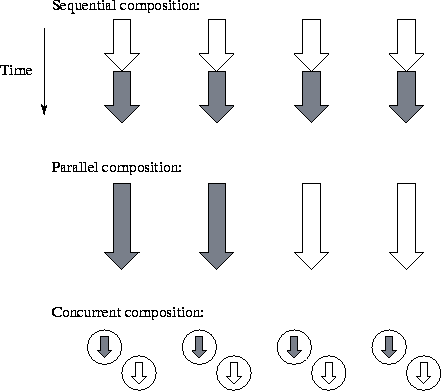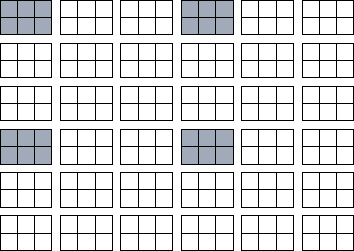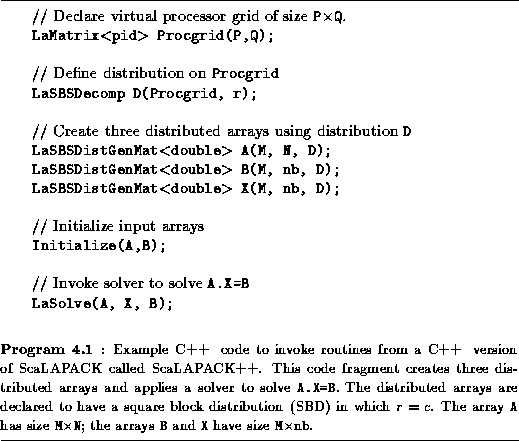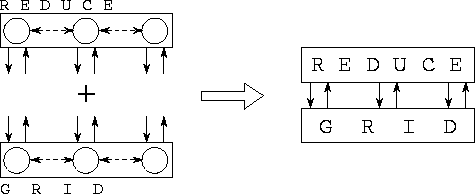![[DBPP]](pictures/asm_color_tiny.gif)





![[Search]](pictures/search_motif.gif)
Next: 4.3 Performance Analysis
Up: 4 Putting Components Together
Previous: 4.1 Modular Design Review
The design principles reviewed in the preceding section apply directly
to parallel programming. However, parallelism also introduces
additional concerns. A sequential module encapsulates the code that
implements the functions provided by the module's interface and the
data structures accessed by those functions. In parallel programming,
we need to consider not only code and data but also the tasks created
by a module, the way in which data structures are partitioned and
mapped to processors, and internal communication structures. Probably
the most fundamental issue is that of data distribution.

Figure 4.1: Three forms of parallel program composition. In each
case, the program is shown executing on four processors, with each arrow
representing a separate thread of control and shading denoting two
different program components. In sequential composition, different
program components execute in sequence on all processors. In parallel
composition, different program components execute concurrently on
different processors. In concurrent composition, different program
components execute concurrently on the same
processors.
Another difference between sequential and parallel programming is that
in the former, modules can be put together (composed) in just one way:
sequentially. Execution of a program leads to a sequence of calls to
functions defined in different modules. This is called
sequential composition
and can also be used in parallel
programming, and indeed is fundamental to the SPMD programming model
used in many parallel programs. However, we often need to compose
program components in other ways (Figure 4.1). In
parallel composition, different modules execute concurrently on
disjoint sets of processors. This strategy can enhance modularity and
improve scalability and locality. In
concurrent composition, different modules execute concurrently
on the same processors, with execution of a particular module enabled
by the availability of data. Concurrent composition can both reduce
design complexity and allow overlapping of computation and
communication.
We distinguish between sequential, parallel, and concurrent
composition both because they are different ways of thinking about
programs and because not all parallel programming tools support all
three compositional forms. Data-parallel languages (such as HPF) tend
to support only sequential composition. Message-passing libraries
(such as MPI) typically support both sequential and parallel
composition but not concurrent composition. Other languages and
libraries (such as CC++
and Fortran M) support all three forms of
composition.
In Chapters 2 and 3, we showed that the
distribution of a program's data structures among tasks and processors
(that is, the way in which data structures are partitioned and mapped)
is an important aspect of parallel algorithm design. We also showed how
to design data distributions that maximize performance and/or minimize
software engineering costs.
Data distribution can become a more complex issue in programs
constructed from several components. Simply choosing the optimal
distribution for each component may result in different modules using
different data distributions. For example, one module may output an
array data structure distributed by columns, while another expects its
input to be distributed by rows. If these two modules are to be
composed, then either the modules themselves must be modified to use
different distributions, or data must be explicitly redistributed as
they are passed from one component to the other. These different
solutions can have different performance characteristics and
development costs.
Both performance tuning and program reuse are made easier if modules
are designed to be data distribution neutral
, that is, if
they can deal with a variety of different data distributions. This
neutrality can be achieved by specifying the distribution of a
particular data structure as a runtime parameter or in the data
structure itself. For example, the two modules referred to in the
preceding paragraph could be defined to deal with arbitrary
two-dimensional decompositions. The combined program could then
utilize a decomposition by rows, a decomposition by columns, or (as a
compromise) a two-dimensional decomposition.
Designing a module to be data distribution neutral is not necessarily
easy. In some cases, different data distributions may call for quite
different algorithms. This issue is explored in more detail in
Section 4.6.
In a parallel program constructed using only sequential composition,
each processor inevitably executes the same program, which in turn
performs a series of calls to different program components. These
program components may themselves communicate and synchronize, but
they cannot create new tasks. Hence, the entire computation moves
sequentially from one parallel operation to the next.
As an example, consider the following program, which could be executed
by each task in an SPMD finite difference program.
while (not done) do
finite_difference(localgrid, localmax)
global_maximum(localmax, globmax)
if(globmax < threshold) done = true
enddo
This program is structured as a sequential composition of two
procedure calls and a conditional statement. At each step, each task
first calls the procedure finite_difference to advance the
simulation on its part of the finite difference grid. This updates
localgrid and returns a local error estimate, localmax.
Next, each task calls global_maximum to obtain a global maximum
error, which is used to determine whether the simulation has
converged. On a parallel computer, both the finite_difference
and global_maximum routines must perform communication (to
exchange the data required by the finite difference stencil and to
compute the global maximum, respectively), but this activity is hidden
from the rest of the program.
This example illustrates an important advantage of sequential
composition and the SPMD model: the program executed by each process
has a fairly straightforward sequential reading, and many sequential
programming techniques can be used unchanged. For example, the
procedures finite_difference and global_maximum can be
defined in separate grid and reduction modules, both of which can
encapsulate internal data structures (and communication structures).
A second advantage of sequential composition is that if different
modules use the same data distribution, no data movement (and hence no
communication) is required at module interfaces. For example, the top-level structure of an SPMD climate modeling system could be as
follows. Procedures from ocean and atmosphere modules are called
repeatedly in an interleaved fashion, with data generated by the ocean
module being passed to the atmosphere module and vice versa.
Communication is required only within the two components.
initialize_ocn(ocn_grid)
initialize_atm(atm_grid)
while (not done) do
ocean(atm_grid, ocn_grid)
atmosphere(ocn_grid, atm_grid, done)
enddo
As these examples show, a library intended for use in an SPMD
programming environment can utilize an interface almost identical to
that used in a comparable sequential library. The principal concerns
are that library routines be able to deal with a variety of data
distributions (that is, be data distribution neutral) and that
parallel implementation details such as data structures and
communication operations be hidden behind interfaces.

Figure 4.2: A block cyclic distribution of a two-dimensional array
of size 12 18 onto a processor array of size 3
18 onto a processor array of size 3 3
( P=Q=3
) with a block size of 2
3
( P=Q=3
) with a block size of 2 3 ( r=2
, c=3
).
Array elements mapped to processor (0,0)
are
shaded.
3 ( r=2
, c=3
).
Array elements mapped to processor (0,0)
are
shaded.
The simplicity of sequential composition and SPMD programming has
stimulated some major parallel library development projects. One
example, which we describe here to illustrate how data distribution
neutral libraries are defined, is ScaLAPACK, a version of the popular
LAPACK linear algebra library designed to execute on scalable parallel
computers. ScaLAPACK supports a wide range of operations on dense and
banded matrices, such as multiplication, transpose, and factorization.
Its routines operate on data objects representing two-dimensional
matrices decomposed by using a block cyclic distribution. The
distribution of an array is specified by four parameters, P
,
Q
, r
, and
c
, where P
and Q
denote the number of processors and
r
and c
the block size in each
dimension (Figure 4.2). In principle, every routine
can be called with any parameter values, so the programmer can
experiment with alternative data distributions simply by changing
parameters in a top-level program. This approach provides a high
degree of mapping independence, in a manner evocative of the data
distribution directives employed in the data-parallel language High
Performance Fortran (HPF) (Chapter 7). In practice,
certain limitations are placed on allowable parameter values so as to
simplify the software. For example, the LU factorization routine
requires that blocks be square. Internally, ScaLAPACK routines may
incorporate multiple parallel algorithms and select between these
algorithms based on distribution, problem size, and machine size.
However, these details are hidden from the user.
Program 4.1 illustrates the use of ScaLAPACK routines.

Not surprisingly, sequential composition also has limitations as a
program structuring technique for parallel programs. We examine some
of these limitations in the subsections that follow.
Parallel composition can be viewed as a generalization of the SPMD
programming model in which different parts of a computer execute
different programs. (It can also be thought of as a special case of
concurrent composition in which concurrently executing tasks are
required to execute on disjoint sets of processors.) A parallel
composition specifies which program components are to execute in which
parts of the computer and how these components are to exchange data.
In principle, any program expressed as a parallel composition can be
converted to a sequential composition that interleaves the execution
of the various program components appropriately. However, the use of
parallel composition can enhance scalability and locality. For
example, if two program components (such as the atmosphere and ocean
model considered in the preceding section) can execute concurrently,
then mapping them to disjoint sets of processors increases scalability
by providing additional opportunities for parallel execution. If
locality increases with granularity, then this parallel composition
can also make more efficient use of cache, memory, and communication
bandwidth than can a sequential composition of the same components.
Parallel composition can also decrease total memory requirements by
reducing the amount of code and data replicated on every processor.
Concurrent composition is the most general form of composition that we
consider. A concurrent composition specifies the program components
that are to execute concurrently, producer/consumer relationships
between components, and the mapping of components to processors.
Components then execute in a data-driven manner, meaning that they can
be executed if the data that they require from other components are
available. These ideas should be familiar from the discussion of the
task/channel programming model in Chapter 1. In the terms
of that model, a concurrent composition specifies a set of tasks, a
set of channels connecting these tasks, and a mapping of tasks to
processors.
Concurrent composition has both advantages and disadvantages relative
to sequential and parallel composition. One important advantage is
that it can facilitate information hiding and hence the development of
modular programs. This is because the interfaces in a concurrent
composition consist entirely of the channels connecting the various
components. Internal implementation details concerning code, data
structures, concurrency, and communication are hidden. Hence, program
components can be designed and developed in isolation even when they
need to execute on the same processors.
Concurrent composition can also simplify design by allowing decisions
concerned with mapping and scheduling to be delayed or even avoided
altogether. Because the semantics of a program specified by using
concurrent composition are independent of how program components are
mapped to processors, mapping decisions can be delayed until late in
the design process, as recommended in Chapter 2. Because
the execution schedule is determined by the availability of data,
execution order need not be specified explicitly by the programmer.
A disadvantage of concurrent composition in some environments is the
cost of a data-driven execution model. While compilers and runtime
systems can do much to reduce costs incurred when switching between
tasks, these costs can be significant if task switches occur
frequently.

Figure 4.3: A finite difference program can be structured as a
concurrent composition of reduce and grid components. The
first of these components is designed to perform reductions, while the
second performs finite difference computation. An array of channels
defines the interface between the two components, which encapsulate
internal task and channel structures. The two components may execute
on the same or different processors.
Example  .
. Finite Difference Problem:
Finite Difference Problem:
Figure 4.3 shows how the finite difference program can be
constructed as a concurrent composition of grid and reduce
components. The grid module might create a set of tasks
specified as follows. The arguments to_reduce and
from_reduce are ports referencing channels that can be used to send
data to and receive data from the reduce module, respectively.
procedure grid(to_reduce, from_reduce)
begin
while(not done) do ! Repeat for each step
exchange_with_neighbors(grid)
compute(grid, localmax) ! Local computation
send(to_reduce, localmax) ! Dispatch request for reduction
other_computation(grid) ! More local computation
receive(from_reduce, globmax) ! Receive reduced value
if(globmax < threshold) done = true
enddo
end
At each step, this code performs some computation before sending a
message requesting a reduction operation, and then performs other
computation before receiving the result. The other computation can be
overlapped with the communication required for the reduction.
We conclude this section with a set of design rules that can be used
to determine how to compose modules and which sorts of interfaces to
design.
-
Design modules to handle multiple data distributions. This feature
can increase their reusability.
-
Incorporate data distribution information in data structures rather
than in module interfaces. This approach simplifies interfaces and
maximizes opportunities for code reuse.
-
Use sequential composition when designing for an SPMD programming
system such as HPF or MPI.
-
Consider sequential composition when program components cannot execute
concurrently or need to share a lot of data.
-
Consider concurrent composition if program components can execute
concurrently, communication costs are high, and
communication/computation overlap is possible.
-
Consider parallel composition if memory is at a premium or if
intracomponent communication costs are greater than intercomponent
communication costs.
![[DBPP]](pictures/asm_color_tiny.gif)





![[Search]](pictures/search_motif.gif)
Next: 4.3 Performance Analysis
Up: 4 Putting Components Together
Previous: 4.1 Modular Design Review
© Copyright 1995 by Ian Foster

![[DBPP]](pictures/asm_color_tiny.gif)





![[Search]](pictures/search_motif.gif)

 18 onto a processor array of size 3
18 onto a processor array of size 3 3
( P=Q=3
) with a block size of 2
3
( P=Q=3
) with a block size of 2 3 ( r=2
, c=3
).
Array elements mapped to processor (0,0)
are
shaded.
3 ( r=2
, c=3
).
Array elements mapped to processor (0,0)
are
shaded.

 .
. Finite Difference Problem:
Finite Difference Problem: